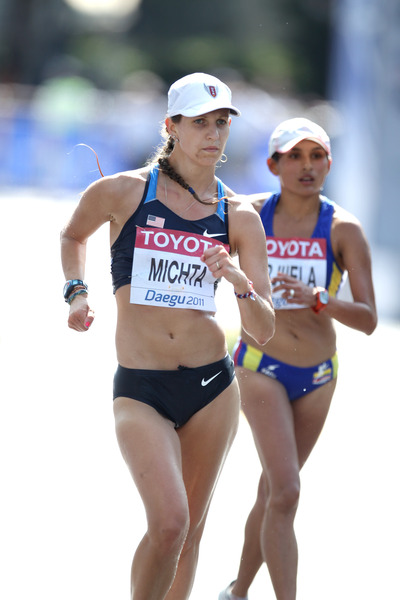 Olga Kaniskina, 2011 World Championships/Daegu, 20km, photo by PhotoRun.net
Olga Kaniskina, 2011 World Championships/Daegu, 20km, photo by PhotoRun.net
Updated September 8, 2011
We asked 1956 Olympian Elliott Denman (50k Race Walk), a noted journalist in the running trade, to cover the walks for us. Elliot did a column on the 20k men’s race on the second day, and he will cover the 50k on Saturday.
Today, he is writing about Olga Kaniskina and her third win in the 20k. We hope that you enjoy Elliot’s work:

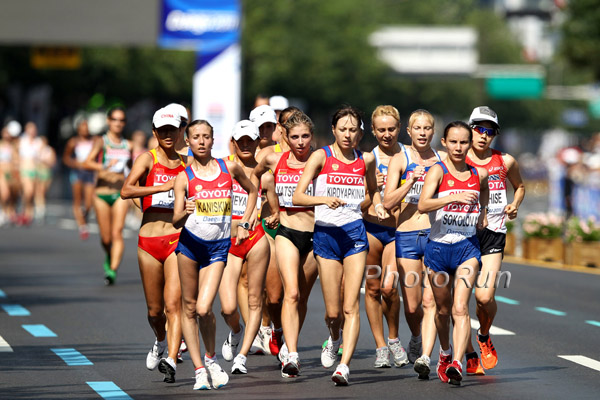
RelatedPosts
By ELLIOTT DENMAN
marathons as separate entities – starting and finishing on enclosed
road courses – kilometers/miles distant from the main stadium venue – a
more inclusive title for all the goings-on seems to be in order.
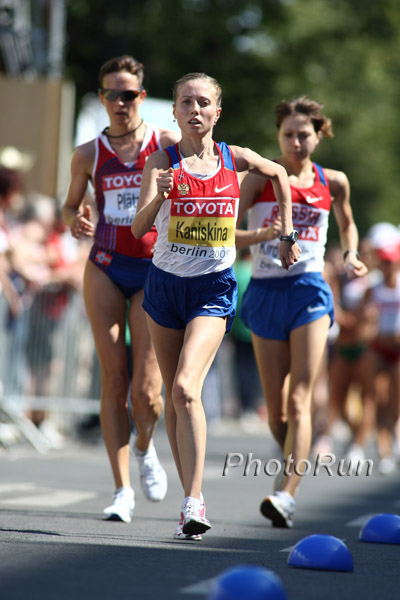 2009 World Champs 20k Walk, Berlin (look whose leading; Kaniskina), photo by PhotoRun.net
2009 World Champs 20k Walk, Berlin (look whose leading; Kaniskina), photo by PhotoRun.netfirst staged the three racewalks – men’s and women’s 20Ks, men’s 50K –
in an iconic city-center location – and the move was hugely successful.
At one point, it was estimated that over 100,000 fans were out there,
on the 2K loop course framed by the classic Brandenburg Gate, cheering
on the planet’s speediest pedestrians. The athletes loved all that
attention, the fans loved the chance to cheer all these world-class
athletes up-close-and-personal (and, oh yes, it was free), and the IAAF
loved the fact that the walkers were finally being appreciated, as
spotlight-grabbers in their own right, rather than as interlopers
breaking up the action at the big stadium.
racewalkers – strutting their stuff in center city – are again getting
the appreciation they may not have been getting when the event was a
start-on-the-stadium-track, head-for-the-exits,
walk-loops-on-some-adjacent-
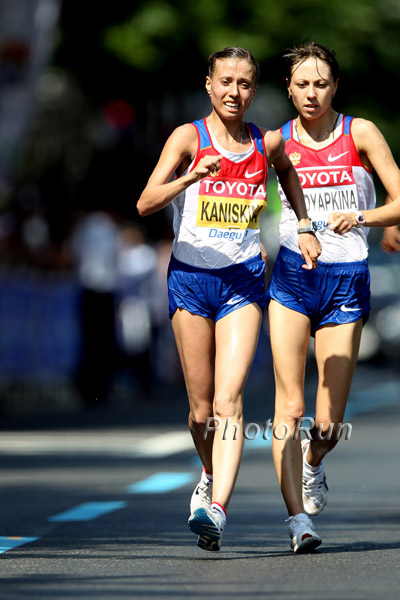 2011 WC/Daegu, 20km, Kaniskina, Kirdyapkina, photo by PhotoRun.net
2011 WC/Daegu, 20km, Kaniskina, Kirdyapkina, photo by PhotoRun.netloop on the famous mall – pronounced “mal’ in Britishese – directly
fronting Buckingham Palace.
asked Peter Marlow, for years and years a mainstay of the IAAF’s
racewalking hierarchy and a leading member of IAAF judging panels for
top events staged around the globe.
here have been working with due diligence and upholding the rules of the
racewalking game – requiring a straightened knee on a walker’s initial
stride landing, and contact with the ground throughout. Bur a key
phrase in the the definition also stipulates “as seen by the human eye.”
In other words, this will remain a decision retained by the men and
women of the panel, not subject to further analysis by technology.
That’s the way the walkers like it, that’s the way the IAAF likes it,
and that’s he way it will continue.
deal with tough calls – witness Usain Bolt’s false start DQ in the 100,
Dayron Robles’ interference DQ in the 110 hurdles – racewalking has been
free of such acrimony. The judges have done their job, get high marks
and continue to be the backbone of racewalking.
six continents – answered the starting call for the 20K at the IAAF’s
13th World Championships. The size of the field and its diversity were
remarkable and the IAAF’s higher-ups surely needed to take note. This,
truly, was an event for the whole planet. Or at least until they start
training racewalkers on the seventh continent – Antarctica.
starts tinkering with the program – and some rumors have the IOC asking
the IAAF to “sacrifice” one of its three racewalks, so that a cross
country run (over snow, presumably) might be added to the Winter Games –
walking’s adherents can point to their event’s great-and-growing
globalism.
DQd to the sidelines) met the approval of the judges’ scrutinous eyes.
Four DNFed in the steamy conditions.
With everything on the line, the remakable Olga
Kaniskina gave it everything she had. With a stunning negative-split
performance, she literally walked away from all pursuers to solidify
her spot as probably the best female walker ever. It took her 1:29:42 –
to win her third consecutive World Championship gold and, with the 2008
Beijing Olympic gold, her fourth straight “major.”
not world record-threatening, (Teammate Vera Sokolova had done a WR
1:25:08 back in February but was just 11th in this one in 1:32:13.)
Kaniskina reminded, “but conditions were not proper” (meaning too few
international judges.)
Mordovian Academy of Racewalking, she had more than enough to outwalk
China’s Hang Liu (second in 1:30 flat), who in turn had caught Russia’s
Anisya Kiryapkina (1:30:13) on the final loop.
fourth in 1:30:44, with China’s Shenjie Qieyang (1:31:14) and Portugal
super-vet Susana Feitor (1:31:26) next across.
11th World Championships – and that puts her number one on the all-time
list. No athlete – of whatever event – had ever competed in 11
Worlds. She’s walked in every edition since Tokyo in 1991, with a best
of third in 2005.
gushed. “It has meant the world to me. It keeps me fit, it keeps me
going, and it keeps me traveling around the world to meet my friends.”
nearly half the race, until the stars started the inevitable separation
process and finally the superstars took off on their own.
team” was Great Briton Jo Jackson, 23rd in 1:35:32. Lone USA delegate
Maria Michta, the C.W. Post College alumna who is a doctoral candidate
in microbiology in New York City, placed 30th in 1:38:54 in the biggest
race of her life. Canada’s Rachel Lavallee Seaman, wife of two-time USA
Olympian Tim Seaman, was 37th in 1:43:41.
completes the three-race Worlds racewalking program. Twenty-five center
city laps. The longest, toughest event at the Championships. Yes,
nearly five miles longer than the marathon.

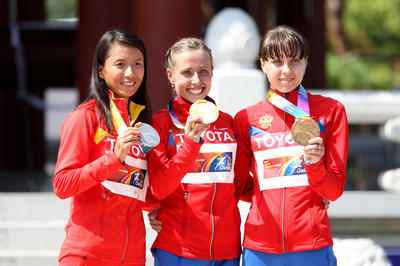
Author

Larry Eder has had a 52-year involvement in the sport of athletics. Larry has experienced the sport as an athlete, coach, magazine publisher, and now, journalist and blogger. His first article, on Don Bowden, America's first sub-4 minute miler, was published in RW in 1983. Larry has published several magazines on athletics, from American Athletics to the U.S. version of Spikes magazine. He currently manages the content and marketing development of the RunningNetwork, The Shoe Addicts, and RunBlogRun. Of RunBlogRun, his daily pilgrimage with the sport, Larry says: "I have to admit, I love traveling to far away meets, writing about the sport I love, and the athletes I respect, for my readers at runblogrun.com, the most of anything I have ever done, except, maybe running itself." Also does some updates for BBC Sports at key events, which he truly enjoys. Theme song: Greg Allman, " I'm no Angel."
View all posts

